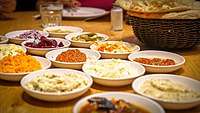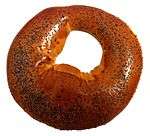Bagel
A bagel (Yiddish: בײגל beygl; Polish: bajgiel), also historically spelled beigel,[1] is a bread product originating in the Jewish communities of Poland. It is traditionally shaped by hand into the form of a ring from yeasted wheat dough, roughly hand-sized, that is first boiled for a short time in water and then baked. The result is a dense, chewy, doughy interior with a browned and sometimes crisp exterior. Bagels are often topped with seeds baked on the outer crust, with the traditional ones being poppy and sesame seeds. Some may have salt sprinkled on their surface, and there are different dough types, such as whole-grain and rye.[2][3] Bagels are eaten toasted or untoasted.
 A commercially produced bagel | |
| Alternative names | Bajgiel, beigel, beygl |
|---|---|
| Type | Bread |
| Place of origin | Poland |
| Region or state | Central & Eastern Europe, North America, Israel |
| Associated national cuisine | Polish, American, Canadian, and Israeli |
| Created by | Jewish communities of Poland |
| Serving temperature | Room temperature |
| Main ingredients | Wheat dough |
| Variations | Montreal-style bagel, East Coast Style Bagel, pizza bagel |
Though the origins of bagels are somewhat obscure, it is known that they were widely consumed by Ashkenazi Jews from the 17th century. The first known mention of the bagel, in 1610, was in Jewish community ordinances in Kraków, Poland.
Bagels are now a popular bread product in North America and Poland, especially in cities with a large Jewish population, many with alternative ways of making them. Like other bakery products, bagels are available (fresh or frozen, often in many flavors) in many major supermarkets in those cities.
The basic roll-with-a-hole design is hundreds of years old and has other practical advantages besides providing more even cooking and baking of the dough: The hole could be used to thread string or dowels through groups of bagels, allowing easier handling and transportation and more appealing seller displays.[4][5]
History
Linguist Leo Rosten wrote in The Joys of Yiddish about the first known mention of the Polish word bajgiel derived from the Yiddish word bagel in the "Community Regulations" of the city of Kraków in 1610, which stated that the food was given as a gift to women in childbirth.[6]
In the 16th and first half of the 17th centuries, the bajgiel became a staple of Polish cuisine[7] and a staple of the Slavic diet generally.[8] Its name derives from the Yiddish word beygal from the German dialect word beugel, meaning "ring" or "bracelet".[9]
Variants of the word beugal are used in Yiddish and in Austrian German to refer to a similar form of sweet-filled pastry (Mohnbeugel (with poppy seeds) and Nussbeugel (with ground nuts), or in southern German dialects (where beuge refers to a pile, e.g., holzbeuge "woodpile"). According to the Merriam-Webster dictionary, 'bagel' derives from the transliteration of the Yiddish 'beygl', which came from the Middle High German 'böugel' or ring, which itself came from 'bouc' (ring) in Old High German, similar to the Old English bēag "ring" and būgan "to bend, bow".[10] Similarly, another etymology in the Webster's New World College Dictionary says that the Middle High German form was derived from the Austrian German beugel, a kind of croissant, and was similar to the German bügel, a stirrup or ring.[11]
In the Brick Lane district and surrounding area of London, England, bagels (locally spelled "beigels") have been sold since the middle of the 19th century. They were often displayed in the windows of bakeries on vertical wooden dowels, up to a metre in length, on racks.

Bagels were brought to the United States by immigrant Polish Jews, with a thriving business developing in New York City that was controlled for decades by Bagel Bakers Local 338. They had contracts with nearly all bagel bakeries in and around the city for its workers, who prepared all their bagels by hand.
The bagel came into more general use throughout North America in the last quarter of the 20th century with automation. Daniel Thompson started work on the first commercially viable bagel machine in 1958; bagel baker Harry Lender, his son, Murray Lender, and Florence Sender leased this technology and pioneered automated production and distribution of frozen bagels in the 1960s.[12][13][14] Murray also invented pre-slicing the bagel.[15]
Around 1900, the "bagel brunch" became popular in New York City.[16] The bagel brunch consists of a bagel topped with lox, cream cheese, capers, tomato, and red onion.[16] This and similar combinations of toppings have remained associated with bagels into the 21st century in the US.[17][18][19]
In Japan, the first kosher bagels were brought by BagelK from New York in 1989. BagelK created green tea, chocolate, maple-nut, and banana-nut flavors for the market in Japan. There are three million bagels exported from the U.S. annually, and it has a 4%-of-duty classification of Japan in 2000. Some Japanese bagels, such as those sold by BAGEL & BAGEL, are soft and sweet; others, such as Einstein Bro. bagels sold by Costco in Japan, are the same as in the U.S.
Preparation and preservation
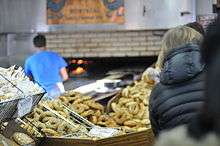
At its most basic, traditional bagel dough contains wheat flour (without germ or bran), salt, water, and yeast leavening. Bread flour or other high gluten flours are preferred to create the firm, dense but spongy bagel shape and chewy texture.[2] Most bagel recipes call for the addition of a sweetener to the dough, often barley malt (syrup or crystals), honey, high fructose corn syrup, or sugar, with or without eggs, milk or butter.[2] Leavening can be accomplished using a sourdough technique or a commercially produced yeast.
Bagels are traditionally made by:
- mixing and kneading the ingredients to form the dough
- shaping the dough into the traditional bagel shape, round with a hole in the middle, from a long thin piece of dough
- proofing the bagels for at least 12 hours at low temperature (40–50 °F = 4.5–10 °C)
- boiling each bagel in water for 60–90 seconds that may contain additives such as lye, baking soda, barley malt syrup, or honey
- baking at between 175 °C and 315 °C (about 350–600 °F)
This production method gives bagels their distinctive taste, chewy texture, and shiny appearance.
In recent years, a variant has emerged, producing what is sometimes called the steam bagel. To make a steam bagel, the boiling is skipped, and the bagels are instead baked in an oven equipped with a steam injection system.[20] In commercial bagel production, the steam bagel process requires less labor, since bagels need only be directly handled once, at the shaping stage. Thereafter, the bagels need never be removed from their pans as they are refrigerated and then steam-baked. The steam bagel results in a fluffier, softer, less chewy product more akin to a finger roll that happens to be shaped like a bagel. The dough used is intentionally more alkaline to aid browning, because the steam injection process uses neutral water steam instead of an alkaline solution bath.
Bagels can be frozen for up to six months.[21]
Quality
According to a 2012 Consumer Reports article, the ideal bagel should have a slightly crispy crust, a distinct "pull" when a piece is separated from the whole by biting or pinching, a chewy inside, and the flavor of bread freshly baked. The taste may be complemented by additions cooked on the bagel, such as onion, garlic, sesame seeds, or poppy seeds. The appeal of a bagel may change upon being toasted. Toasting can have the effect of bringing or removing desirable chewiness, softening the crust, and moderating off-flavors.[22]
A typical bagel has 260–350 calories, 1.0–4.5 grams of fat, 330–660 milligrams of sodium, and 2–5 grams of fiber. Gluten-free bagels have much more fat, often 9 grams, because of ingredients in the dough to supplant the wheat flour of the original.[22]
Varieties
New York style
The New York bagel contains malt, is cold-fermented for several days to develop the flavors and enhance the crust, and is boiled in salted water before baking in a standard oven.[23] The resulting bagel has a fluffy interior and a chewy crust. There is a widespread belief that New York bagels are the best due to the quality of the local water.[24] However, the superiority of the New York Bagel is likely due to the preparation methodology.
East Coast style
The East Coast style bagel has qualities that compare to the New York-style bagel and Montreal-style bagel, while also uniquely incorporating sourdough. This sourdough mixture features a unique set of ingredients only found in Halifax in the form of locally sourced wild yeasts. The East Coast-style bagel is not as chewy and fluffy, nor as salty as the New York-style bagel, and is less dense, doughy and sweet than a Montreal-style bagel, with an added dash of San Francisco influence.[25]
Montreal style

Different from the New York style, the Montreal-style bagel contains malt and sugar with no salt; it is boiled in honey-sweetened water before baking in a wood-fired oven. It is predominantly of the sesame "white" seeds variety (bagels in Toronto are similar to those made in New York in that they are less sweet, generally are coated with poppy seeds and are baked in a standard oven).
St. Louis style
The St. Louis style bagel refers not to composition, but to a particular method of slicing the bagel.[26] The St. Louis style bagels are sliced vertically multiple times, instead of the traditional single horizontal slice.[26] The slices range from 3 mm to 6 mm [1/4 to 1/8 inches] thick.[27] This style of bagel was popularized by the St. Louis Bread Company, now known as Panera Bread.[26] Generally, the bagels are sliced into eight pieces using a bread slicer, which produces characteristically precise cuts (the bagel is not torn or crushed while slicing).[27] This particular method of preparation increases the surface area available for spreads (e.g., cream cheese, butter).[26] However, it decreases the portability of the bagel and prevents formation of sandwiches.[28]
Other bagel styles
As suggested above, other bagel styles can be found elsewhere, akin to the way in which families in a given culture employ a variety of methods when cooking an indigenous dish. Thus, Chicago-style bagels are baked or baked with steam. The traditional London bagel (or beigel as it is spelled) is harder and has a coarser texture with air bubbles.
Poppy seeds are sometimes referred to by their Yiddish name, spelled either mun or mon (written מאָן), which comes from the German word for poppy, Mohn, as used in Mohnbrötchen. American chef John Mitzewich suggests a recipe for what he calls “San Francisco-Style Bagels”. His recipe yields bagels flatter than New York-style bagels, characterized by a rough-textured crust.[29] An everything bagel may include such toppings as poppy seeds, sesame seeds, onion flakes, caraway seeds, garlic flakes, pretzel salt, cinnamon raisin and pepper.
Non-traditional doughs and types
While normally and traditionally made of yeasted wheat, in the late 20th century variations on the bagel flourished. Non-traditional versions that change the dough recipe include pumpernickel, rye, sourdough, bran, whole wheat, and multigrain. Other variations change the flavor of the dough, often using blueberry, salt, onion, garlic, egg, cinnamon, raisin, chocolate chip, cheese, or some combination of the above. Green bagels are sometimes created for St. Patrick's Day.
Many corporate chains now offer bagels in such flavors as chocolate chip and French toast.
Sandwich bagels have been popularized since the late 1990s by specialty shops such as Bruegger's and Einstein Brothers, and fast food restaurants such as McDonald's.
Breakfast bagels, a softer, sweeter variety usually sold in fruity or sweet flavors (e.g., cherry, strawberry, cheese, blueberry, cinnamon-raisin, chocolate chip, maple syrup, banana and nuts) are common at large supermarket chains. These are usually sold sliced and are intended to be prepared in a toaster.
A flat bagel, known as a 'flagel', can be found in a few locations in and around New York City, Long Island, and Toronto. According to a review attributed to New York's Village Voice food critic Robert Seitsema, the flagel was first created by Brooklyn's 'Tasty Bagels' deli in the early 1990s.[30]
The New York Style Snacks brand has developed the baked snacks referred to as Bagel Crisps and Bagel Chips, which are marketed as a representation of the "authentic taste" of New York City bakery bagels.[31]
Though the original bagel has a fairly well-defined recipe and method of production, there is no legal standard of identity for bagels in the United States. Bakers are free to call any bread torus a bagel, even those that deviate wildly from the original formulation.
Large scale commercial sales
United States supermarket sales
2008
According to the American Institute of Baking (AIB), 2008 supermarket sales (52-week period ending January 27, 2009) of the top eight leading commercial fresh (not frozen) bagel brands in the United States:
- totaled to US$430,185,378 based on 142,669,901 package unit sales.[32]
- the top eight leading brand names for the above were (by order of sales): Thomas', Sara Lee, (private label brands) Pepperidge Farm, Thomas Mini Squares, Lender's Bagels (Pinnacle Foods), Weight Watchers and The Alternative Bagel (Western Bagel).[32]
Further, AIB-provided statistics for the 52-week period ending May 18, 2008, for refrigerated/frozen supermarket bagel sales for the top 10 brand names totaled US$50,737,860, based on 36,719,977 unit package sales.[33] Price per package was $3.02 for fresh, $1.38 for frozen.
2012
The AIB reported US$626.9 million fresh bagel US supermarket sales (excluding Wal-Mart) for the 52 weeks ending 11 April 2012.[34] Fresh/frozen supermarket sales (excluding Wal-Mart) for the 52 weeks ending 13 May 2012 was US$592.7 million.[34] The average price for a bag of fresh bagels was $3.27; for frozen it was $1.23.
Similar breads
Many cultures developed similar breads and preparations. The bublik in Russia, Ukraine and Belarus, and the obwarzanek (in particular obwarzanek krakowski) in Poland are essentially larger bagels with a wider hole. Somewhat similar in appearance to bagels, these breads are usually topped with sesame and poppy seeds. The ingredients in these breads and bagels somewhat differ, as these breads often are made with butter[35] and sometimes also with milk,[36] which are forbidden to be used in bagels due to kashrut, or Jewish religious dietary laws. Other ring-shaped breads known among East Slavs are baranki (smaller and drier) and sushki (even smaller and drier). In Lithuania, similar breads are called riestainiai, or sometimes by their Slavic name baronkos.
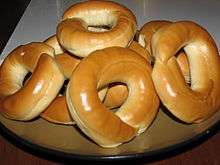
In Finland, vesirinkeli are small rings of yeast-leavened wheat bread. They are placed in salted boiling water before being baked. They are often eaten for breakfast toasted and buttered. They are available in many varieties (sweet or savoury) in supermarkets.
German pretzels (which are soft and formed into rings or long rectangular shapes) are somewhat similar to bagels in texture, the main exceptions being the shape and the alkaline water bath that makes the surface dark and glossy.
In Romania, covrigi are topped with poppy, sesame seeds or large salt grains, especially in the central area of the country. The recipe does not contain any added sweetener. They are usually shaped like pretzels rather than bagels.
In some parts of Austria, ring-shaped pastries called Beugel are sold in the weeks before Easter. Like a bagel, the yeasted wheat dough, usually flavored with caraway, is boiled before baking. However, the Beugel is crispy and can be stored for weeks. Traditionally it has to be torn apart by two individuals before eating.
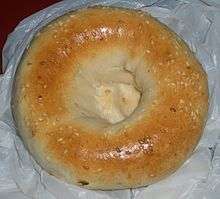
In Turkey, a salty and fattier form is called açma. The ring-shaped simit is sometimes marketed today as a Turkish bagel. Archival sources show that the simit has been produced in Istanbul since 1525.[37] Based on Üsküdar court records (Şer’iyye Sicili) dated 1593,[38] the weight and price of simit was standardized for the first time. Noted 17th-century traveler Evliya Çelebi wrote that there were 70 simit bakeries in Istanbul during the 1630s[39]
Jean Brindesi's early 19th-century oil paintings about Istanbul daily life show simit sellers on the streets.[40] Warwick Goble made an illustration of the simit sellers of Istanbul in 1906.[41] Simit is very similar to the twisted sesame-sprinkled bagels pictured being sold in early 20th century Poland. Simit are also sold on the street in baskets or carts, as bagels were then.
The Uyghurs of Xinjiang, China enjoy girdeh nan (from Persian, meaning round bread), a type of nan, the local bread.[42]
Cultural references
"Bagel" is also a Yeshivish term for sleeping 12 hours straight—e.g., "I slept a bagel last night." There are various opinions as to the origins of this term. It may be a reference to the fact that bagel dough has to "rest" for at least 12 hours between mixing and baking[43] or simply to the fact that the hour hand on a clock traces a bagel shape over the course of 12 hours.
In tennis, a "bagel" refers to a player winning a set 6–0; winning a match 6–0, 6–0, 6–0 is called a "triple bagel".[44]
"Bublitchki" or "Bagelach" is a title of a famous Russian and Yiddish song written in Odessa in the 1920s. The Barry Sisters together with the Ziggy Elman Orchestra made it popular in the US in 1939. Today it belongs to the repertoire of klezmer, jazz and pop musicians.
In Quizbowl, a "bagel" refers to failing to correctly answer any part of a multi-part bonus question (i.e. "We bageled that bonus on the Franco-Mongol alliance in the first finals match."). This is because a bagel looks like the number zero, which is the points gained by incorrectly answering all of the questions.[45]
In America, February 9 is often celebrated as National Bagel Day,[46] in which people celebrate the rich history of getting together and eating bagels.
The term "bageling" refers to when a Jew drops a Jewish word or phrase in a conversation or in the vicinity of a stranger who's clearly Jewish, to tell the other person that he's also Jewish.[47]
See also
References
Citations
- Definition: Beigel, retrieved from Dictionary.com website July 11, 2011
- Encyclopædia Britannica (2009) Bagel, retrieved February 24, 2009 from Encyclopædia Britannica Online
- Roden, Claudia (1996). "The Book of Jewish Food: An Odyssey from Samarkand to New York”. Excerpt, retrieved April 7, 2015 from My Jewish Learning
- Nathan, Joan (2008). “A Short History of the Bagel: From ancient Egypt to Lender's”. Slate, posted Nov. 12, 2008
- Columbia University NYC24 New Media Workshop website ”History of the Bagel: The Hole Story” Archived 2011-08-22 at the Wayback Machine, retrieved February 24, 2009.
- Filippone, Peggy Trowbridge. “Bagel History: Bagels date back to the 1600s”, About.com website, retrieved March 27, 2013.
- Altschuler, Glenn C. (2008). ”Three Centuries of Bagels”, a book review of: 'The Bagel: The Surprising History of a Modest Bread', by Balinska, Maria, Yale University Press, 2008, Jewish Daily Press website, published on-line November 05, 2008 in the issue of November 14, 2008
- Zinovy Zinik,'Freelance,' in Times Literary Supplement, Nov., 18, 2011, p. 16.
- Davidson, Alan (2006). Oxford Companion to Food (2nd ed.). Oxford: Oxford University Press. p. 49. ISBN 978-0192806819.
- Merriam-Webster's Dictionary definition of 'bagel', Merriam-Webster Inc. online, 2009, retrieved 2009-04-24
- Webster's New World College Dictionary definition of 'bagel', Wiley Publishing Inc., Cleveland, 2005, retrieved 2009-04-24;
- Klagsburn, Francine. "Chewing Over The Bagel’s Story", The Jewish Week, July 8, 2009. Accessed July 15, 2009.
- Hevesi, Dennis (2012-03-22). "Murray Lender, Who Gave All America a Taste of Bagels, Dies at 81". The New York Times. Retrieved 2012-04-19.
- Rothman, Lily (2012-03-23). "Murray Lender, the man who brought bagels to the masses". The Washington Post. Retrieved 2012-04-19.
- "Murray Lender". The Economist. 21 April 2012. Retrieved 30 August 2012.
- Adamson, M.W.; Segan, F. (2008). Entertaining from Ancient Rome to the Super Bowl: An Encyclopedia: An Encyclopedia. ABC-CLIO. p. 94. ISBN 978-0-313-08689-2.
- Parker, Milton; Freeman, Allyn (2005). How to Feed Friends and Influence People: The Carnegie Deli: A Giant Sandwich, a Little Deli, a Huge Success. Hoboken, NJ: John Wiley & Sons. p. 97. ISBN 0471710350. Retrieved 2015-12-20.
- Clark, Melissa (2013-09-24). "Setting Out the Bagels and Lox". The New York Times. Retrieved 2015-12-20.
- Warner, Justin (2015). The Laws of Cooking* *and How to Break Them. New York: Flatiron Books. p. 83. ISBN 978-1250065131. Retrieved 2015-12-20.
- Reinhart, P. (2001).The Bread Baker's Apprentice. Ten Speed Press, p. 115.
- Jonathan, Croswell. How to Keep a Bagel Moist, August 8, 2011.
- "Top Bagels – Bagel Buying Guide". Consumer Reports. July 2012.
- {{cite web|title=The untold truth of New York bagels|url=https://www.mashed.com/150118/the-untold-truth-of-new-york-bagels/%7Cwebsite=Mashable%7Cpublisher=%7Caccessdate=04 August 2020|
- "Bagels, water and an urban legend". CNN. Archived from the original on 14 November 2015. Retrieved 18 May 2015.
- "The bagel". Bakers Journal. Retrieved 2018-07-15.
- McDowell, Maya (2019-03-28). "In Defense Of The Bread-Sliced Bagel, From A St. Louis Native". Delish. Retrieved 2019-03-30.
- "Bread-slicing Machine". National Museum of American History. Retrieved 2019-03-30.
- "Apparently People Slice Bagels Like Bread In St. Louis And Honestly? WTF". BuzzFeed News. Retrieved 2019-03-30.
- Mitzewich, John (August 6, 2012). "San Francisco-Style Bagels – Taking Things to a Hole New Level". Food Wishes. Blogger. Retrieved August 7, 2012.
- Browne, Alaina Flagel = Flat Bagel (review), retrieved 2009-04-24 from SeriousEats.com website;
- "New York Style Baked Snacks". Newyorkstyle.com. Retrieved 2018-03-26.
- Baking Management (2008) AIB website data: Bagels 2008, from Baking Management, p. 10, March 2009, Statistics from Information Resources, retrieved 2009-03-23 from American Institute of Baking website: Bagels 2008 updated to March 10, 2009;
- Baking Management (2008) AIB website data: Bagels 2008, from Redbook, July 2008, p. 20, Statistics from Information Resources. retrieved 2009-03-23 from American Institute of Baking website: Bagels 2008 updated to March 10, 2009
- AIB International, Bagels 2012. Data obtained from SymphonyIRI Group from scanner data from Supermarkets, Drugstores, and Mass Merchandisers (does not includeWal-Mart).
- Victoria Drey (19 March 2019). "Bubliki: The star of a Russian-style bagel brunch". Russian Beyond.
- "Bublik". The Bread Guru. Retrieved 11 October 2019.
- Sahillioğlu, Halil. “Osmanlılarda Narh Müessesesi ve 1525 Yılı Sonunda İstanbul’da Fiyatlar”. Belgelerle Türk Tarihi 2 [The Narh Institution in the Ottoman Empire and the Prices in Istanbul in Late 1525. Documents in Turkish History 2] (Kasım 1967): 56
- Ünsal, Artun. Susamlı Halkanın Tılsımı.[The Secret of the Ring with Sesames] İstanbul: YKY, 2010: 45
- Evliya Çelebi Seyahatnâmesi Kitap I. [The Seyahatname Book I] (Prof. Dr. Robert Dankoff, Seyit Ali Kahraman, Yücel Dağlı). İstanbul: YKY, 2006: 231
- Jean Brindesi, Illustrations de Elbicei atika. Musée des anciens costumes turcs d'Istanbul, Paris: Lemercier, [1855]
- Alexander Van Millingen, Constantinople (London: Black, 1906) https://www.gutenberg.org/files/39620/39620-h/39620-h.htm
- Allen, Thomas B. (March 1996). "Xinjiang". National Geographic Magazine, pp. 36–37
- Balinska 2008. pp. 4–5.
- Collins, Bud; Hollander, Zander (1994). Bud Collins' Modern Encyclopedia of Tennis (2, illustrated ed.). Visible Ink Press. pp. 484–85. ISBN 978-0-8103-9443-8.
- Eltinge, Stephen. "Quizbowl Lexicon". Partnership for Academic Competition Excellence. Retrieved 2020-06-12.
- "Home". National Bagel Day. Retrieved 2018-03-26.
- "Bageling". Jewish English Lexicon. Retrieved July 27, 2020.
Bibliography
- Balinska, Maria (2008). The Bagel: The Surprising History of a Modest Bread, Yale University Press, ISBN 0-300-11229-7, 978-0-300-11229-0
External links
| Wikimedia Commons has media related to Bagels. |
- Bagels Return To the Lower East Side (origin of American bagels)
- The Bagel's History on H2G2
- Einstein, Brothers. The History of Bagels, October 20, 2009
- Nathan, Joan. A Short History of Bagels, Slate, November 12, 2008
- Weinzweig, Ari. The Secret History of Bagels, The Atlantic, March 26, 2009
